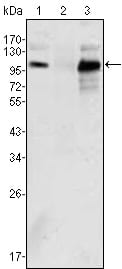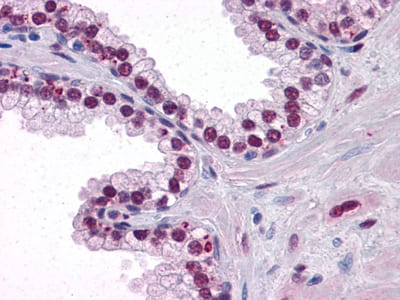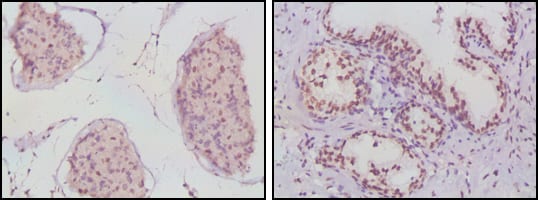


| WB | 1/500 - 1/2000 | Human,Mouse,Rat |
| IF | 咨询技术 | Human,Mouse,Rat |
| IHC | 1/200 - 1/1000 | Human,Mouse,Rat |
| ICC | 技术咨询 | Human,Mouse,Rat |
| FCM | 咨询技术 | Human,Mouse,Rat |
| Elisa | 1/10000 | Human,Mouse,Rat |
| Aliases | NR3C4; KD; AIS; SMAX1; HUMARA; AR |
| Entrez GeneID | 367 |
| clone | 2H8 |
| WB Predicted band size | 110kDa |
| Host/Isotype | Mouse IgG1 |
| Antibody Type | Primary antibody |
| Storage | Store at 4°C short term. Aliquot and store at -20°C long term. Avoid freeze/thaw cycles. |
| Species Reactivity | Human |
| Immunogen | Purified recombinant fragment of human AR expressed in E. Coli. |
| Formulation | Purified antibody in PBS with 0.05% sodium azide. |
+ +
以下是3-4篇关于雄激素受体(Androgen Receptor, AR)抗体的参考文献及其摘要概括:
---
1. **文献名称**: *Androgen receptor expression in prostate cancer tissues is associated with poor efficacy of endocrine therapy*
**作者**: Bubendorf L, et al.
**期刊/年份**: *Am J Pathol* (1999)
**摘要**: 该研究通过免疫组化(IHC)分析前列腺癌组织中AR的表达水平,验证了特定AR抗体的可靠性,并发现AR高表达与内分泌治疗疗效降低相关。
---
2. **文献名称**: *Androgen receptor splice variants mediate enzalutamide resistance in castration-resistant prostate cancer*
**作者**: Gregory CW, et al.
**期刊/年份**: *Cancer Res* (2012)
**摘要**: 研究利用Western blot和免疫沉淀技术,通过特异性AR抗体发现AR剪接变异体(AR-V7)的存在与恩杂鲁胺耐药性相关。
---
3. **文献名称**: *Kinase-mediated regulation of the androgen receptor through phosphorylation*
**作者**: Heemers HV, et al.
**期刊/年份**: *Mol Endocrinol* (2007)
**摘要**: 描述了针对AR磷酸化位点的特异性抗体开发,揭示激酶通过磷酸化调控AR的转录活性及稳定性。
---
4. **文献名称**: *A critical role for histone-modifying enzymes in AR signaling*
**作者**: Tanner T, et al.
**期刊/年份**: *J Biol Chem* (2010)
**摘要**: 研究使用AR抗体进行染色质免疫沉淀(ChIP),阐明组蛋白修饰酶与AR协同调控靶基因的机制。
---
这些文献涵盖了AR抗体在基础研究与临床中的应用,包括表达分析、耐药机制及翻译后修饰研究。如需具体实验方法或抗体克隆号,可进一步查阅原文。
×